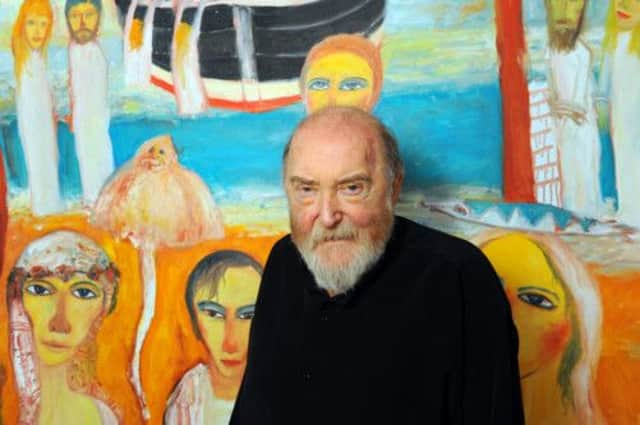Scottish artist John Bellany dies at 71


Born in Port Seton, near Edinburgh, Bellany, the son of a fisherman, attended Edinburgh College of Art and the Royal College of Art in London.
He rejected the new fashionable wave of abstraction sweeping the art world in the 1960s and instead was determined to create a new form of Scottish art inspired by his upbringing.
Advertisement
Hide AdHe also drew inspiration from Scottish poet Hugh MacDiarmid and fellow artist Alan Davie.
The statement on Bellany’s official website revealing the news of his death read: “It is with great sadness that we announce the passing of a true Scottish giant.
“At 17 minutes past seven on the evening of Wednesday 28th August John passed away, in his studio, surrounded by his family. He was clutching a paintbrush in his hand as he took his final breath. His passion was life and he painted as if each day was his last.”
Last year, the National Galleries of Scotland (NGS) held a major Bellany retrospective entitled A Passion for Life which featured not only his large-scale paintings of the fishing community but also works inspired by a visit to the Bergen-Belsen concentration camp.
Last night, Sir John Leighton, director-general of the NGS, said: “John Bellany will be celebrated as one of Scotland’s greatest artists of the modern era. From his early, heroic depictions of fisherfolk on the Scottish coast to the vibrant, passionate images of his later years he gave visual form to the big themes and narratives of human life.
“The retrospective show at the National Galleries last autumn demonstrated how he was able to use the drama and crises of his own life as a starting point for powerful explorations of man’s struggle with fate and, as he entered his 70s, it seemed as if he was still at the top of the game. We are extremely sad to hear of his death, but his art will remain an inspiration to artists long in to the future.”
Advertisement
Hide AdArtist Richard Demarco said Bellany should be thought of as a great “European” artist who captured the human condition.
“He was a one-off. He dared to paint a reality which had been ignored – a community living a hard existence on the shores of the Firth of Forth.”
Advertisement
Hide AdAuthor Ian Rankin, a fan of Bellany’s work who owns a number of the artist’s original works, said: “He was one of my favourite artists and I was fortunate enough to meet him once or twice. He already managed to dodge death before and after being hospitalised returned brim full of life. His fans will miss him a lot. He had a life which seemed as expansive as the life in his paintings.”
Bellany suffered bouts of depression which led to heavy drinking. He gave up alcohol, but in 1988 he had to have a liver transplant due to the damage caused by this earlier way of life.
Last year he said: “I have had an absolutely incredible 30 years of life since the transplant.”
In 2005 he suffered a heart attack in Glasgow.
In recent years his work was also inspired by the landscapes of countries which he loved including Italy, Mexico and China.
Bellany was awarded the CBE in 1994.
Susan Mansfield: ‘Bellany’s passion for life was inseparable from his art’
JOHN Bellany seized hold of life with both hands. His retrospective exhibition last autumn at the Scottish National Gallery was subtitled A Passion for Life.
Advertisement
Hide AdThat he died in his studio with a paintbrush in his hand is fitting. Bellany’s passion for life was inseparable from his art. When he regained consciousness after a life-saving liver transplant in 1988, he asked for pencils and paper. It was the same after a heart attack in 2005. As long as he was making art, he knew he was alive.
When I interviewed him at his home in Saffron Walden, Essex, last autumn, I was astonished by the large, ambitious canvases which filled his studio. Bellany might have had trouble climbing the stairs, but a 5ft deep canvas was there to be conquered.
Advertisement
Hide AdBellany’s work was shaped by his upbringing in the fishing towns of Port Seton and Eyemouth. There, seeds were planted for a lifetime of material: a cache of imagery, woven into a personal mythology. He married this with a love of the Old Masters and European symbolists. His work always has colour and vitality, even in his darker days. And there were dark days: drinking and liver failure, divorce, a second marriage to Juliet Lister which ended when she took her own life. But there were also remarkable acts of grace: reconciliation with his first wife, Helen (whom he remarried in 1987), and three children, a dotage spent delighting in his grandchildren.
At the opening of his retrospective last November, his eyes sparkled with pride. As a cocky young art student, he had exhibited his own paintings on the railings outside the building. Now, the whole gallery was filled with his work. One hopes that, as he neared the end of life, he could feel satisfied at what he achieved, and know the depth to which he was appreciated.